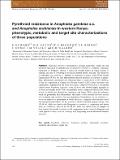| dc.contributor.author | E. OCHOMO, M. N. BAYOH, W. G. BROGDON, J. E. GIMNIG, C. OUMA, J. M. VULULE, E. D. WALKER | |
| dc.date.accessioned | 2021-05-26T08:13:15Z | |
| dc.date.available | 2021-05-26T08:13:15Z | |
| dc.date.issued | 2012 | |
| dc.identifier.uri | https://repository.maseno.ac.ke/handle/123456789/3849 | |
| dc.description.abstract | Field and laboratory investigations revealed phenotypic, target site and metabolic resistance to permethrin in an Anopheles gambiae s.s. (Diptera: Culicidae) population in Bungoma District, a region in western Kenya in which malaria is endemic and rates of ownership of insecticide-treated bednets are high. The sensitivity of individual An. gambiae s.l. females as indicated in assays using World Health Organization (WHO) test kits demonstrated reduced mortality in response to permethrin, deltamethrin and bendiocarb. Estimated time to knock-down of 50% (KDT50) of the test population in Centers for Disease Control (CDC) bottle bioassays was significantly lengthened for the three insecticides compared with that in a susceptible control strain. Anopheles arabiensis from all three sites showed higher mortality to all three insecticides in the WHO susceptibility assays compared with the CDC bottle assays, in which they showed less sensitivity and longer KDT50 than the reference strain for permethrin and deltamethrin. Microplate assays revealed elevated activity of β-esterases and oxidases, but not glutathione-S-transferase, in An. gambiae s.s. survivors exposed to permethrin in bottle bioassays compared with knocked down and unexposed individuals. No An. arabiensis showed elevated enzyme activity. The 1014S kdr allele was fixed in the Bungoma An. gambiae s.s. population and absent from An. arabiensis, whereas the 1014F kdr allele was absent from all samples of both species. Insecticide resistance could compromise vector control in Bungoma and could spread to other areas as coverage with longlasting insecticide-treated bednets increases. | en_US |
| dc.publisher | Wiley Online Library | en_US |
| dc.title | Pyrethroid resistance in Anopheles gambiae s.s. and Anopheles arabiensis in western Kenya: phenotypic, metabolic and target site characterizations of three populations | en_US |
| dc.type | Article | en_US |

